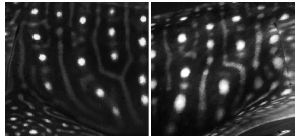 |
| Typical Photo ID in Cetaceans |
The use of photographic individual recognition is commonly associated
with cetacean research and allows the identification of individuals or entire
pods through the use of creating dorsal of fluke libraries allowing subsequent
picture comparison. The benefit of such systems is due to the use of key body
structures such as notch's, scars and defining features that allows individuals to be recognised.
It has long been known that dorsal fins and flukes can be used in individual recognition
due to equivalent fingerprint quality. This has therefore allowed individuals to
be tracked and re-identified throughout the globe via these libraries
highlighting huge migratory patterns undertaken by large marine vertebrates.
Examples of photo libraries exist within almost all major cetacean research groups
including that of Sea Watch situated within Cardigan Bay and also that of hebridean
whale and dolphin trust. Though such a technique is applied to cetaceans and
its application within other marine animals is growing due to its un-invasive
application and growing reliability in comparison congenital tags that have
high failure rates. Recent studies have been conducted on Whale sharks and
Loggerhead turtles to establish its viability as a recognition device and population
estimate technique.
 |
| Whale Shark Individual Spot and Stripe Markings |
The study looking at whale
sharks was conducted at Ningaloo Reef Western Australia (Meekan et al., 2006) which
has annual whale shark aggregations and allows the opportunity to formulate
population estimates and sex ratios from these large highly migratory pelagic
species. Similar to that of dorsal fins whale sharks have individual spots and striped markings behind the gills allowing for individual recognition, similarly the usage
of prominent scars and fins is additionally used. The study illustrates 100% success
rate with the use of high quality pictures and highlights the role that tour operators
can have in providing images in to aid in conservation efforts though the study
did depict the need of some training aspect to ensure viable photos. Key findings within the study illustrates predominately
make biased sex ratios within the population visiting Ningaloo Reef in addition
to highlight migratory pathways undertaken by certain individuals due to both subsequent
annual visits and visits involving large time scale breaks. Similarly the areas
of further investigation is that of the coupling of worldwide or even region
photo data bases that could allow the mapping of migratory routes and through
the use of pop-up tags could allow potentially entire migratory pathways to be
mapped which has been previously been attempted in other pieces of
research (Eckert et al., 2002)
The second trial was looking at the use of facial (post-ocular)
scales to identify turtles in a non-invasive way whilst scuba diving or snorkelling
through photo identification, allowing for the collection of population estimates
separately from just laying females. This trial study illustrated clear positive
possibilities in the identification of non-nesting females and illusive males
to be added to population and sex ratio estimates. It was illustrated that 100%
matching was achievable within a 400
individual data set through trained observers and that positive matching could
be enhanced through the use of short training sessions given to untrained observed/volunteers
(Shofiled et al.,2008).
 |
| Facial Scale Recognition in Logger Head Turtle Carreta carreta |
References:
Eckert SA. Dolar LL. Kooyman GL. Perrin W. Rahman RA. 2002. Movements of whale sharks (Rhincodon typus) in South- east Asian waters as determined by satellite telemetry. Journal of Zoology, 257, 111-115.
Meekan MG. Bradshaw CJ. Press M. Mclean C. Richards A. Quasnichka. Taylor JG. 2006. Population size and structure of whale sharks Rhincodon typus at Ningaloo Reef, Western Australia.Marine Ecology Progress Series, 319, 275-285.
Schofield G. Karselidis KA. Dimopoulos P. Pantis JD.,2008. Investigating the viability of photo-identification as an objective tool to study endangered sea turtle populations. Journal of Experimental Marine Biology and Ecology, 360,103-108.
No comments:
Post a Comment